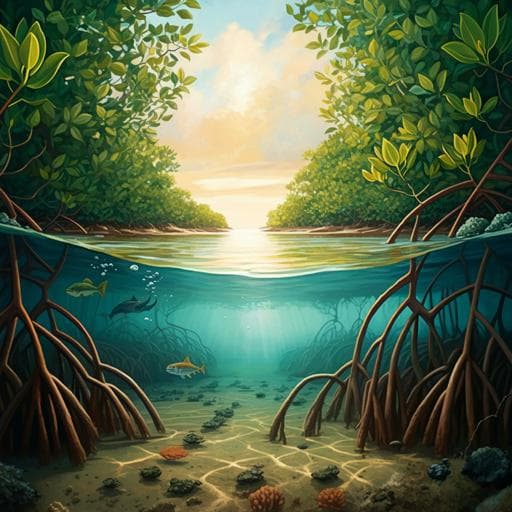
Environmental Studies and Forestry
Vegetated coastal ecosystems in the Southwestern Atlantic Ocean are an unexploited opportunity for climate change mitigation
V. Hatje, M. Copertino, et al.
This paper reveals groundbreaking insights into organic carbon storage in the Central and Southwestern Atlantic coastal ecosystems, emphasizing the critical role of mangroves in carbon accumulation. With an estimated 0.4 Pg of organic carbon stored and a significant annual accumulation, this research underscores the urgent need for conservation efforts in these vital ecosystems. This significant study was conducted by Vanessa Hatje, Margareth Copertino, Vinicius F. Patire, Ximena Ovando, Josiah Ogbuka, Beverly J. Johnson, Hilary Kennedy, Pere Masque, and Joel C. Creed.
~3 min • Beginner • English
Introduction
Blue Carbon designates the CO2 captured from the atmosphere and stored by coastal and marine ecosystems. The concept underscores the importance of conserving and restoring vegetated coastal ecosystems (VCE)—mangroves, saltmarshes, and seagrass meadows—to support climate mitigation and adaptation. Although VCE occupy a small fraction of the seafloor (~0.5%), they account for a disproportionately large share of organic carbon burial in marine sediments and deliver multiple ecosystem services, including coastal protection, fisheries support, biodiversity enhancement, and increased resilience to sea-level rise and extreme events. Yet, VCE are being converted and degraded, risking a shift from carbon sinks to CO2 sources and adding to anthropogenic greenhouse gas emissions. Regional and macroscale assessments are needed to quantify organic carbon (OC) stocks and sequestration rates to inform policy, management, and inclusion of VCE in Nationally Determined Contributions. The Southwestern Atlantic (SWA) likely contains Blue Carbon hotspots (e.g., vast equatorial mangroves and extensive temperate seagrass meadows), but available data are sparse and geographically biased. This study systematically reviews and synthesizes aboveground biomass and soil OC stocks and sequestration rates for SWA VCE from Guyana to Argentina to consolidate knowledge, identify gaps, and assess their potential contribution to climate mitigation strategies.
Literature Review
The authors note that globally available Blue Carbon datasets are uneven and geographically biased, with suspected hotspots such as the Southwestern Atlantic under-represented. While robust estimates exist for nearby terrestrial systems (e.g., the Amazon), comparable VCE inventories and sequestration rates in the SWA are limited. Previous global and regional studies establish VCE as major OC sinks and highlight their role in natural climate solutions, but reveal inconsistencies in mapping (especially for seagrasses), methodological variability, and poor coverage of accumulation rates. Recent global syntheses provide ranges for OC stocks and burial rates, yet local controls (e.g., tidal amplitude, sediment supply, proximity to rivers, species composition) and anthropogenic impacts remain incompletely resolved. The literature indicates that mangrove soil OC stocks fall within broad global ranges, saltmarshes can have very high OC densities in certain regions (e.g., Falklands/Malvinas), and seagrass OC stocks are variable and often lower where meadows are patchy and composed of smaller, ephemeral species. Identified gaps include insufficient soil data for saltmarshes and seagrasses across several SWA ecoregions, and scarce or absent accumulation rate measurements for saltmarshes and most seagrass systems.
Methodology
The study region spans the Southwestern Atlantic from Guyana (08.82°N, 58.00°W) to Tierra del Fuego, Argentina (55.14°S), encompassing multiple Marine Ecoregions of the World (MEOW). A systematic literature search (Web of Science, Google Scholar, CAPES dissertations/theses) compiled peer-reviewed and gray literature data on aboveground biomass and soil OC stocks and, where available, carbon accumulation rates (CAR) or mass accumulation rates (MAR) for mangroves, seagrasses, and saltmarshes. Data extraction prioritized dry bulk density (DBD) and OC measurements (concentrations, densities, or stocks). Loss-on-ignition (LOI) values were converted to OC using published empirical relationships when needed; DBD was used to calculate stock densities where available. Soil OC stocks were standardized to the top 1 m; where cores were shorter, depth profiles were extrapolated to 1 m using reported depth-integrated OC content. Aboveground biomass C was derived from reported values or species-specific factors; a general conversion factor was used if species C data were absent. For mangroves, above- and belowground biomass and soil OC were summed when consistent. For seagrasses and saltmarshes, aboveground biomass and soil OC data were compiled across sites; root data for saltmarshes were not available. Areas by ecoregion were assembled from existing datasets: mangrove area from regional/global products, saltmarsh extent from literature and mapping, and seagrass occurrence from MapBiomas (Brazil), the UN WCMC global seagrass database, and expert-validated occurrence points aggregated to polygons (1 km² buffers) and upscaled by ecoregion. Ecosystem- and ecoregion-level OC stocks were calculated by multiplying mean stocks per unit area by mapped areas. Soil accumulation rates were compiled from 210Pb-dated sediment cores (excess 210Pb profiles, including gamma spectrometry) when available; where MAR was reported, CAR was estimated using OC content. For ecosystems lacking CAR data (notably saltmarshes and most seagrasses), global literature values were consulted to contextualize ranges. Statistical tests (normality via Shapiro–Wilk, homogeneity via Cochran) guided comparisons among ecosystems; ANOVA/Tukey or Kruskal–Wallis/Dunn tests assessed differences at α=0.05. Units were standardized to Mg C ha−1 for stocks and Tg C yr−1 for sequestration. Data and detailed procedures are provided in Supplementary Information and Mendeley Data.
Key Findings
- Total OC stock and sequestration: The SWA stores an estimated 0.4 Pg organic carbon (≈2–5% of global VCE soil OC) and accumulates 0.5–3.9 Tg C yr−1, corresponding to ~0.7–13% of global VCE sequestration rates. A separate estimate in discussion suggests ~0.29 Pg C (1–4% of global Blue Carbon stocks), reflecting conservative area assumptions and data limitations.
- Ecosystem contributions: Mangroves have the largest area (~1.2 Mha) and contribute 70–80% of annual OC sequestration in the region; Brazil hosts ~95% of SWA mangrove stocks. Saltmarshes and mangroves have comparable total stocks per unit area (≈380 vs 330 Mg C ha−1), whereas seagrass soils are lower on average.
- Areal extents (SWA): Mangroves ~1.2 Mha (≈9–15% of global mangrove area); saltmarshes ~0.18 Mha (≈4–8% of global); seagrasses ~0.073 Mha (≈0.1–0.4% of mapped global area; deep-water Halophila decipiens not included, so likely conservative).
- Stocks per unit area (means): Soils—saltmarshes 372 ± 47 Mg C ha−1; mangroves 259 ± 151 Mg C ha−1; seagrasses 91 ± 82 Mg C ha−1. Aboveground biomass C—mangroves 72 Mg C ha−1, much higher than seagrasses (0.32 Mg C ha−1) and saltmarshes (7.8 Mg C ha−1).
- Regional variability: Total ecosystem OC stocks varied widely by ecoregion: mangroves 20–244 Tg C, saltmarshes 0.2–31 Tg C, seagrasses 0.003–11 Tg C. Amazonia mangroves have ~3× higher aboveground stock per area than subtropical SE Brazil, but subtropical SE Brazil shows higher soil OC per area than equatorial regions.
- Sequestration rates (CAR): Mangrove CAR ranges 0.1–11 Mg C ha−1 yr−1 (mean 2.6 ± 1.9; median 2.9), exceeding global average (1.6 ± 0.4) and Australian average (1.3 ± 0.9). Mangrove soil sequestration rates are up to two orders of magnitude higher than seagrass and higher than reported saltmarsh maxima. No published saltmarsh soil CAR data were found for SWA; seagrass CAR data are scarce.
- National distribution: In Brazil, mangroves represent ~93% of national VCE OC stocks; nearly all SWA seagrass OC stocks are in Brazil. Saltmarshes account for ~10% of OC stocks in Argentina and Uruguay.
- Disturbance and emissions: Between 1999–2018, Brazil lost ~2% of mangroves (~0.1% yr−1), similar to global trends; French Guiana, Guyana, and Suriname show annual losses of ~0.24%, 0.6%, and 0.38%. Conversion to shrimp ponds in northern Brazil caused 58–89% carbon stock losses, with potential emissions reported up to ~1390 Mg CO2 ha−1 yr−1; erosion-driven losses dominate in the Amazon and NE Brazil. Potential CO2 emissions from mangrove loss in Brazil are substantial, and mitigation via conservation/restoration could yield measurable climate benefits and financial returns.
Discussion
The synthesis demonstrates that the Southwestern Atlantic hosts substantial Blue Carbon stocks and sequestration capacity, dominated by mangroves, with saltmarshes providing comparable soil OC densities per unit area and seagrasses contributing conservatively estimated stocks due to mapping gaps. These findings address the central question by quantifying regional OC inventories and accumulation rates, showing that SWA VCE represent a meaningful fraction of global Blue Carbon and thus constitute a significant nature-based climate mitigation opportunity. Latitudinal and ecoregional differences in stocks and CAR reflect interacting controls, including tidal amplitude, sediment supply and grain size, riverine inputs, geomorphology, climate, and species composition, overlaid by anthropogenic pressures. The higher-than-global-average mangrove CAR underscores the regional importance of protecting these forests. Documented losses and associated CO2 emissions highlight the vulnerability of SWA Blue Carbon hotspots to erosion, extreme events, aquaculture expansion, and land-use change. Integrating VCE into NDCs and carbon finance mechanisms could incentivize conservation and restoration, enhancing coastal resilience and ecosystem services while delivering verified climate benefits. However, the strong geographic and ecosystem-specific data gaps (especially for seagrass and saltmarsh soils and their accumulation rates) constrain precision in regional carbon accounting and point to urgent research needs.
Conclusion
The Southwestern Atlantic is a Blue Carbon hotspot, storing on the order of 0.4 Pg OC (≈2–5% of global VCE soil stocks) and sequestering 0.5–3.9 Tg C yr−1 (≈0.7–13% of global VCE rates). Mangroves dominate total stocks (≈337 Tg C) and sequestration (≈0.14–2.6 Tg C yr−1), while saltmarshes and mangroves have comparable OC stocks per unit area. Despite significant knowledge gaps—particularly in seagrass and saltmarsh distribution, soil stocks, and accumulation rates—the consolidated baseline provided here supports inclusion of VCE in national/regional climate strategies and carbon markets. Conservation and restoration can mitigate ongoing and historical losses, safeguard ecosystem services, and contribute to NDCs. Future research should prioritize: improved and consistent mapping (notably for seagrasses and saltmarshes, including deep-water habitats); broader, standardized soil coring to 1 m with DBD and OC measurements; expansion of 210Pb-dated CAR datasets across ecosystems; better quantification of belowground biomass/root contributions; and assessments of drivers (riverine/tidal inputs, geomorphology, climate, and human impacts) to refine regional carbon budgets and management interventions.
Limitations
- Data coverage and geographic bias: Soil stock and CAR data are sparse or absent for many ecoregions, especially for seagrasses and saltmarshes (e.g., limited or no soil data in Guiana, Northeastern and Eastern Brazil for saltmarshes; deep-water seagrasses not accounted for). Mangrove soil data are patchy in northern ecoregions.
- Mapping uncertainties: Seagrass extent is particularly uncertain due to small, patchy, and turbid-water meadows; models may overpredict in unsuitable habitats (e.g., Amazon delta). Deep-water meadows (e.g., Halophila decipiens) likely cause underestimation.
- Methodological heterogeneity: Studies vary in sampling depth, measurements (DBD, OC), and use of LOI-to-OC conversions; some cores are shorter than 1 m and require extrapolation. Belowground biomass/root contributions are poorly constrained (few studies quantify fine roots separately), adding uncertainty to total ecosystem stock estimates.
- Accumulation rates: CAR data are limited (no saltmarsh CAR for SWA; scarce seagrass CAR), necessitating reliance on global ranges for context and likely underestimating regional totals.
- Statistical and scaling assumptions: Upscaling from site means to ecoregions assumes representativeness across heterogeneous settings; area estimates and polygon buffering for seagrass occurrences introduce spatial uncertainty.
Overall, estimates are conservative and likely represent lower bounds for stocks and sequestration.
Related Publications
Explore these studies to deepen your understanding of the subject.







